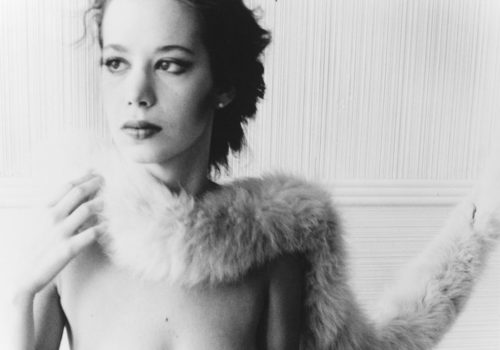One rarely thinks of Francesca Woodman in clothing, since her most well known works show her nude and posing in enigmatic and disturbingly beautiful scenes. In a seductive exhibition this month at the Goodman Gallery in New York, however, clothes play a central role. The thirty images on display here explore a little-known chapter in the short and prolific career of Francesca Woodman: her passion for fashion. Three quarters of the pictures have never been exhibited. There are self-portraits, of course, but also staged photographs with models whose identity remains a mystery even today.
Woodman plays with fabric, light, texture and nature, all while staying true to the poetry of her decayed interiors. Here she speaks in a different way of her fascination with women, their form and associated aesthetic. The style is less raw and melancholic than usual. The subject is sometimes brought to the fore and accompanied by animals—stuffed, sculpted, skinned—a detail that contrasts deeply with the purity of her style. As Alison Gingeras, author of an associated essay, writes, the dark atmosphere of a large part of these photographs evokes the work of Deborah Turbeville, famous photographer of the genre, who Francesca Woodman tried to meet repeatedly in the early 1980s in an attempt to assist her. “Early inspirations for this body of work, as noted by scholars, included Surrealist traditions as well as Gothic proclivities that had previously infused her work. However the fashion pictures also suggest the influence of such photographers as Deborah Turbeville, who was aptly navigating a balance between commercial and critical success with her melancholic, narrative images, and Guy Bourdin, whose fetishized female subjects may have been objects of Woodman’s fascination. Mirroring the paradigms pioneered by the triumvirate of fashion photographers that ruled the pages of Vogue in the late 1970s—Helmut Newton, Guy Bourdin, and Deborah Turbeville—Woodman’s approach to the genre shunned the simple foregrounding of clothes and accessories. Emulating this Seventies fashion editorial archetype, Woodman’s images were deliberately constructed to entice the viewer into consuming a complex story rather than the products that might be featured in the pictorial.”
Although these photographs were taken in New York in the final years of her life, between 1978 and 1980, Woodman’s interest for fashion dates back to childhood trips with her mother to Italy, visiting museums, where the young Francesca would make sketches of women in elegant robes. Some precious documents, marked by an early admiration for aesthetics, that are now found in the archives held by her parents, as well as in her work and artist books. “Fashion had become a vital tool for both Woodman’s emerging artistic practice as well as for her self-definition,” writes Gingeras. “More than just providing props, fashion was a creative catalyst in her life and in her image making.” From an early age, she had a “conceptual understanding of fashion as a powerful signifier and performative tool. ”
The exhibition I’m trying my hand at fashion photography—the title is taken from something she had written on a few photographs—points to the unfathomable character of Woodman’s oeuvre, to the image that is at once complete and forbidden, and therefore the antithesis of the fashion world. Learning that Woodman saw fashion photography as a possible future livelihood almost dispels the Woodman myth of the “cursed artist.”
EXHIBITION
I’m trying my hand at fashion photography
Francesca Woodman
Through March 13th 2015
Marian Goodman Gallery
24 West 57TH Street
New York, NY 10019
212-977-7160
















